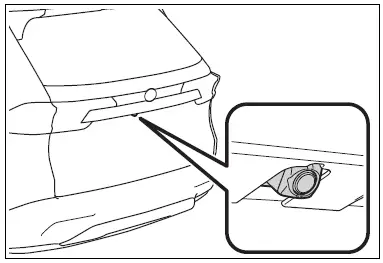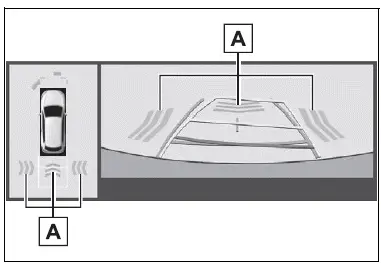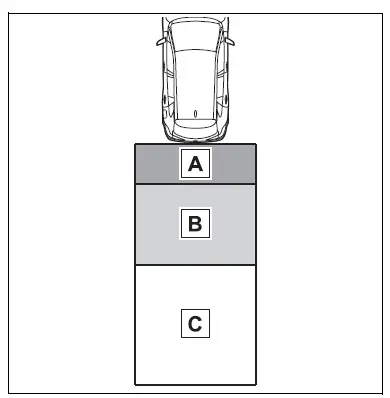Toyota Grand Highlander (AS10) 2024 Owners Manual / Driving / Using the driving support systems / RCD (Rear Camera Detection)
Toyota Grand Highlander (AS10): RCD (Rear Camera Detection)
When the vehicle is backing up, the rear camera detection function can detect pedestrians in the detection area behind the vehicle. If a pedestrian is detected, a buzzer will sound and an icon will be displayed on the Multimedia Display to inform the driver of the pedestrian.
WARNING
■Cautions regarding the use of the system
The recognition and control capabilities for this system are limited.
The driver should always drive safely by always being responsible without over relying on the system and have a understanding of the surrounding situations.
■To ensure the system can operate properly
Observe the following, otherwise there is the danger that could lead to an accident.
- Always clean the camera without damaging it.
- Do not install market electronic parts (such as illuminated license plate, fog lamps, etc.) in the camera vicinity.
- Do not subject the camera vicinity to strong impacts. If the vicinity is subjected to a strong impact, have the vehicle inspected by your Toyota dealer.
- Do not disassemble, remodel or paint the camera.
- Do not attach accessories or stickers to the camera.
- Do not install market protection parts (bumper trim, etc.) to the rear bumper.
- Maintain suitable tire air pressure.
- Make sure the back door is completely closed.
■RCD function is turned off
In the following situations the system turns off. The RCD function may not operate properly and thus there is the danger that an accident may occur.
- The contents mentioned above are not observed.
- Suspensions other than the genuine parts are installed.
System component
Location of the rear camera

RCD display

- Pedestrian detection icon
Displayed automatically when a pedestrian is detected behind the vehicle.
Turning the RCD function on/off
The RCD function can be enabled/disabled through a customize setting.
When the RCD function is disabled, the driving assist information indicator illuminates, and a message is displayed on the multi-information display.
Each time the engine switch is turned off then changed to ON, the RCD function will be enabled automatically.
When a pedestrian is detected
If a pedestrian is in the area behind the vehicle or if the rear camera detected that a pedestrian is approaching the vehicle from behind, the system urges caution from the driver by sounding the buzzer and displaying the detection of a pedestrian on the Multimedia Display as follows:

- If a pedestrian is detected in
area A
Buzzer: Sounds repeatedly Pedestrian detection icon: Blinks - If a pedestrian is detected in
area B
Buzzer (When the vehicle is stationary): Sounds 3 times Buzzer (When the vehicle is backing up, when a pedestrian approaches the rear of the vehicle): Sounds repeatedly Pedestrian detection icon: Blinks - If the system determines that
your vehicle may collide with
a pedestrian in area C
Buzzer: Sounds repeatedly Pedestrian detection icon: Blinks
■The rear camera detection function is operational when
- The engine switch is in ON.
- RCD function is on.
- The shift position is in R.
■Setting the buzzer volume
The buzzer volume of the intuitive parking assist, RCTA, and RCD can all be changed at once from the customize settings.
■Muting a buzzer temporarily
When an object is detected, the temporary mute switch is displayed on the Multimedia Display. Select the switch to mute a buzzer of the intuitive parking assist, RCTA, and RCD all together.
Mute will be automatically canceled in the following situations:
- When the shift position is changed.
- When the vehicle speed exceeds a certain speed.
- When there is a malfunction in a sensor or the system is temporarily unavailable.
- When the operating function is disabled manually.
- When the engine switch is turned off.
■Situations in which the system may not operate properly
- Some pedestrians, such as the
following, may not be detected by
the rear camera detection function,
preventing the function from
operating properly:
- Pedestrians who are bending forward or squatting
- Pedestrians who are lying down
- Pedestrians who are running
- Pedestrians who suddenly appear from the shadow of the vehicle or a building
- Pedestrians who are riding moving objects such as a bicycle or skateboard
- Pedestrians wearing oversized clothing such as a rain coat, long skirt, etc., making their silhouette obscure
- Pedestrians whose body is partially hidden by an object, such as a cart or umbrella
- Pedestrians which are obscured by darkness, such as at night
- In some situations, such as the
following, pedestrians may not be
detected by the rear camera
detection function, preventing the
function from operating properly:
- When backing up in inclement weather (rain, snow, fog, etc.)
- The lens is dirty (by dirt or snow-melting agent, etc.) or scratched
- When a very bright light, such as the sun, or the headlights of another vehicle, shines directly into the rear camera
- When backing up in a place where the surrounding brightness changes suddenly, such as at the entrance or exit of a garage or underground parking lot
- When backing up in a dim environment such as during dusk or in an underground parking lot
- When the camera position and direction are deviated
- When a towing hook is attached
- When water droplets are flowing on the camera lens
- When the vehicle height is extremely changed (nose up, nose down, etc.)
- When tire chains or an emergency tire puncture repair kit are used
- When the suspension has been lowered or tires that have a different size than the genuine tires are installed
- When an aftermarket electronic part (backlit license plate, fog light, etc.) is installed near the rear camera
- If a bumper protector, such as an additional trim strip, is installed to the rear bumper
- When towing with the vehicle
■Situations in which the system may operate unexpectedly
- Even though there are no pedestrians
in the detection area, some
objects, such as the following,
may be detected, possibly causing
the rear camera detection
function to operate.
- Three dimensional objects, such as a pole, traffic cone, fence, or parked vehicle
- Moving objects, such as a car or motorcycle
- Objects moving toward your vehicle when backing up, such as flags or puddles (or airborne matter, such as smoke, steam, rain, or snow)
- Cobblestone or gravel roads, tram rails, road repairs, white lines, pedestrian crossings or fallen leaves on the road
- Metal covers (gratings), such as those used for drainage ditches
- Objects reflected in a puddle or on a wet road surface
- Shadows on the road
- In some situations, such as the
following, the rear camera detection
function may operate even
though there are no pedestrians in
the detection area.
- When backing up toward the roadside or a bump on the road
- When backing up toward an incline/decline
- When the vehicle height is extremely changed (nose up, nose down, etc.)
- When an aftermarket electronic part (backlit license plate, fog light, etc.) is installed near the rear camera
- If a bumper protector, such as an additional trim strip, is installed to the rear bumper
- If the orientation of the rear camera has been changed due to a collision or other impact, or removal and installation
- If a towing eyelet is installed to the rear of the vehicle
- When water is flowing over the rear camera lens
- The lens is dirty (by dirt or snow-melting agent, etc.)
- If there is a flashing light in the detection area, such as the emergency flashers of another vehicle
- When tire chains or an emergency tire puncture repair kit are used
- When towing with the vehicle
- Situations in which the rear camera
detection function may be difficult
to notice
- The buzzer may be difficult to hear if the surrounding area is noisy or the audio system volume is high.
- If the temperature in the cabin is extremely high or low, the Multimedia Display may not operate correctly.
Similar pages:
BSM (Blind Spot Monitor)
The Blind Spot Monitor is a
system that uses rear side
radar sensors installed on
the inner side of the rear
bumper on the left and right
side to assist the driver in
confirming safety when
changing lanes.
WARNING
■Cautions regarding the use of
the system
The driver is solely responsible
for sa ...
Head-up display
The head-up display projects
a variety of driving-
related information and
the operating state of the
driving support systems on
the windshield.
System components
Can be changed the head-up
display type.
The content displayed will differ
according to the driving conditions
and display mode of the
...


